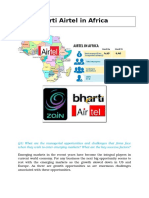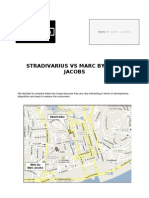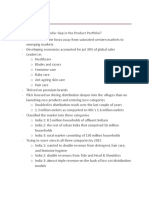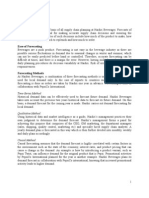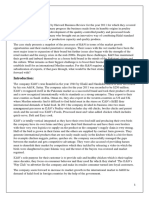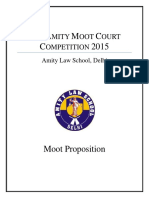0 ratings0% found this document useful (0 votes)
808 viewsK&N'S
K&N'S
Uploaded by
Naseeba MubeenK&N's is a vertically integrated poultry company in Pakistan founded in 1964 by Khalil Sattar to address malnutrition problems. It is now the largest broiler chick producer and processed chicken market leader. Key challenges include competition from wet markets, electricity outages increasing costs, and relationship issues with retailers conducting price promotions. The company focuses on the growing middle class and exports to countries like UAE and Afghanistan but depends on domestic growth. It aims to close the gap between production and processing capacity.
Copyright:
© All Rights Reserved
Available Formats
Download as DOCX, PDF, TXT or read online from Scribd
K&N'S
K&N'S
Uploaded by
Naseeba Mubeen0 ratings0% found this document useful (0 votes)
808 views8 pagesK&N's is a vertically integrated poultry company in Pakistan founded in 1964 by Khalil Sattar to address malnutrition problems. It is now the largest broiler chick producer and processed chicken market leader. Key challenges include competition from wet markets, electricity outages increasing costs, and relationship issues with retailers conducting price promotions. The company focuses on the growing middle class and exports to countries like UAE and Afghanistan but depends on domestic growth. It aims to close the gap between production and processing capacity.
Original Description:
case analysis
Copyright
© © All Rights Reserved
Available Formats
DOCX, PDF, TXT or read online from Scribd
Share this document
Did you find this document useful?
Is this content inappropriate?
K&N's is a vertically integrated poultry company in Pakistan founded in 1964 by Khalil Sattar to address malnutrition problems. It is now the largest broiler chick producer and processed chicken market leader. Key challenges include competition from wet markets, electricity outages increasing costs, and relationship issues with retailers conducting price promotions. The company focuses on the growing middle class and exports to countries like UAE and Afghanistan but depends on domestic growth. It aims to close the gap between production and processing capacity.
Copyright:
© All Rights Reserved
Available Formats
Download as DOCX, PDF, TXT or read online from Scribd
Download as docx, pdf, or txt
0 ratings0% found this document useful (0 votes)
808 views8 pagesK&N'S
K&N'S
Uploaded by
Naseeba MubeenK&N's is a vertically integrated poultry company in Pakistan founded in 1964 by Khalil Sattar to address malnutrition problems. It is now the largest broiler chick producer and processed chicken market leader. Key challenges include competition from wet markets, electricity outages increasing costs, and relationship issues with retailers conducting price promotions. The company focuses on the growing middle class and exports to countries like UAE and Afghanistan but depends on domestic growth. It aims to close the gap between production and processing capacity.
Copyright:
© All Rights Reserved
Available Formats
Download as DOCX, PDF, TXT or read online from Scribd
Download as docx, pdf, or txt
You are on page 1of 8
Cases In Management
K&Ns: Health and Happiness for Pakistan
Submitted to: Mr. Talha Salam
1/28/2014
Naseeba Mubeen
Roll number: 13L-5268
Cases In Management 2014
Page 1
1. Case Summary and Industry Review
Case Summary
In 1964, Khalil Sattar had a vision to provide better nutrition for the health and happiness of his nation.
Now a fully vertically integrated poultry enterprise, started by Khalil along with his wife Naushaba Khalil
(hence the name K&Ns), are today the market leader for processed chicken products and largest broiler
chick producers in Pakistan. Malnutrition was a major problem in Pakistan and to overcome this
problem company operated on a core principle to produce safe and healthy protein to meet the
nutritional needs of the country. In doing so, Khalil believed that chicken would meet the nutrition
needs in less cost. However, wet market was the largest competitor. Adil Sattar, son of Khalil Sattar,
joined the company in 1997 and was responsible for strategy implementation while his father was
responsible for strategy development. The biggest challenge was of availability of electricity which had
increased energy as well as supply chain costs.
In 2011, K&Ns were categorized its business into two areas; K&Ns Poultry and K&Ns Foods. Primary
challenge for the company was to raise consciousness and awareness for safety food without creating
any undue concern of consumers for chicken and poultry industry. K&Ns brand was built on Halal
compliance but their major competitor wet markets had the ability to ensure consumers of the Halal
slaughter of the birds. In 2003, company opened retail stores but the problem they faced with that was
the lack of experienced retail staff to hire. In 2009, loyalty program was initiated and it was successful as
70% of customers shopping at chicken stores were its members. The company focused on middle class
and people who aspire to be middle class. As the size of the class grows, so does the business.
Advertisements of competitors had increased overall chicken consumption. The company won many
brand awards.
International retailers entered Pakistan in the period of economic growth period and it was expected to
grow as the middle class was growing. However, there were some constraints as the economic activity
slowed after the 2008 recession and global financial crisis and the outages of electricity was a major
problem. The company coped with electricity outage problem by engaging with a partner and
developing eutectic freezer plates and freezers to be embedded in trucks walls and placed in chicken
stores respectively. Company enjoyed strong brand recognition and are suppliers to most of the
international and domestic restaurants franchises including KFC, Nandos, McDonalds and others.
Competitors of the company are wet markets, Menu, Mon Salwa and Dawn. Prices of chicken fluctuate
considerably in this volatile industry. The next phase for the company was to close the gap between
broiler chicks produced and broilers used in processing facility and options were considered in doing so
which included increasing domestic sales, export chicken and tap into Halal products market.
Relationships of the company with international and domestic retailers has not been positive and it has
been a challenge as they run price promotions which is counter to their uniform price for all retailers.
Other challenges included importing chicken in 2011.
The company started receiving orders form UAE and Afghanistan but the dependence on exporting was
still a concern. Khalil feared that tomorrow these countries can develop their own facilities. The new
Cases In Management 2014
Page 2
growing opportunity was to enter Halal food market. Khalil urged government on the behalf of Pakistan
Poultry Association to get Pakistan approved as a meat exporter and reduce taxes but the reply was not
satisfactory and he wondered when Pakistan would be a truly healthy and happy nation.
Industry Review
At the time of the case Poultry industry of Pakistan had been volatile in nature and a small scale
broiler industry
Prices of live birds fluctuating consistently throughout the year based on the demand
Volume of broilers production increased in 2010 but problems like consumer resistance to
chicken and eggs existed
Wet markets were wide spread and strong as they consisted 98% of chicken sales but the trend
was expected to change as Government had decided to give 100% ownership to international
retailers and due to the growth of middle class.
Another challenge was absence of organized route to market for increased volume of chicken
There were consistent legislative changes. Changes in tax on short notice and without industry
consultation led many companies to exit the market.
After the reduced consumption of food at weddings, in order to reduce the perceived social
pressure, industry faced a serious collapse in profitability and led many entrepreneurs exit the
market.
Major problems were the unavailability of quality feeds, inconsistent pricing and regular
outbreaks of animal diseases such as bird flu
Labor was cheap and available which was attractive to international companies but industrys
volatile nature was not supportive as market price was roller coaster depending ion supply and
demand and cost of feed.
Low priority was given for quality and safety of food by consumers
CEO of K&Ns brought appropriate technology to raise the industry standards and learned the
dynamics of international poultry industry. He encouraged other players to adopt the
technology and shared information. As a result, the dynamics of industry changed.
In 1999, increase in sales tax and withholding tax highly discouraged the business and many
wrapped up their businesses
Khalil Sattar urged the government on behalf of the Pakistan Poultry Association to make
Pakistan approved meat exporter and reduce the tax.
K&Ns changed the industry dynamics and their processed led to increased productivity which in
turn attracted many entrepreneurs and new capital into the industry.
PEST
Political Factors:
Consistent legislative changes as there were changes in tax on short notice and without industry
consultation
Government allowed international retailers to open their stores with 100% ownership which
resulted in increase of retail quality
Cases In Management 2014
Page 3
In 2011, the trend of importing chicken from other countries was increasing which caused a
major problem was local manufacturers
Global financial crisis and recession still existed after 2008
16% sales tax along with high percentage of industry inputs tax discouraged exporting meat to
neighboring countries although poultry imprinted from China only faced 16% import duty.
Economic Factors:
There is rapid urbanization
A 10% growth in middle class and are expected to grow even more
Supply and demand controlling meat prices as prices of chicken are high in wedding seasons and
are low otherwise.
The growth has been slow since the ban was lifted on exporting poultry products and country
faced recession after 2008
Country is facing high inflation and it is hard to access capital at reasonable rates of interest
Labor is cheap and available but productivity is low
Major problem faced by the country was electricity shortage and in consequence companies
either lose production or pay for their own backup generators
Competition between international and domestic retailers was increasing
Social Factors:
The number of women working outside is increasing and as a result the trend of supermarket
and convenience shopping is also increasing
General level of education has increased and as a result middle class of the country is growing
There is no exception in the Halal way of slaughtering the poultry animals and wet markets have
the ability to reassure the consumers as they slaughter the birds in front of them
There is still a 50% ban on wedding food and it is a problem in making profits
Health and safety of food is not a major concern for the people of the country
A large percentage of household income is spent on food in Pakistan
24% of population living below the poverty line.
Technological Factors:
Lack of access to quality feeds for broilers due to which K&Ns built their own feed mill
No proper measures to control bird diseases were a common norm in the industry
Broiler houses were not located away from parent flocks and other producers and the diseases
could spread easily
Porters Five Forces Model
Threat of New Entrants:
There are relatively high barriers to entry in the industry. Therefore, threat of new entrants is
low. The reasons of high barriers to entry are:
Cases In Management 2014
Page 4
It is a capital intensive process to invest in processing plants to produce safe meat.
However, wet markets do not need large capital investments as their entire focus is
does not lie in producing safe and healthy meat and they are a major threat.
Existing products with strong brand name and USPs such as K&Ns, Dawn and Menu
increase customer loyalty and make it difficult for new companies to gain market share.
Lack of access to quality feed and cold supply chain
Bargaining Power of the supplier
Suppliers are not in powerful position in Poultry industry as there are a number of
suppliers and the price of meat heavily depends on buyers.
Substitutes of the resource are available
Although there is a threat of forward integration from suppliers
Bargaining Power of the Buyer
The buyers and customers are in power as their demand plays a vital role in changing
the prices of poultry products
Threat of backward integration exists in Pakistan as customers may decide to keep
animals and birds in their homes.
Threat of Substitute Products
There are substitutes to meat and consumers can abandon the use of meat if there are
threats of animal diseases
Degree of Competitive Rivalry
There are potential competitors but just a few in the poultry industry
There is a high degree of product loyalty and product differentiation
High investment in innovation and new products
High percentage of fixed costs
2. K&Ns has been successful so far. YES/NO? WHY? HOW?
K&Ns has changed the industry dynamics and is a market leader for processed chicken. Khalil Sattar had
a vision to meet the nutrition needs of the country and in doing so he had built the largest chicken
processor and the market and brand leader for processed chicken and value added chicken products.
However, the problem of low priority given to safety of food still remains. Consumers are more inclined
to buy from wet markets at low prices and only a few hygiene conscious prefer high quality processed
meat. The situation of inflation also attracts the consumers to opt for cheaper sources such as wet
markets. Brand has built its leadership position in the industry through continuous investments in
marketing and innovation. Yes, they have enjoyed their success in Pakistan with loyal customer base but
the current situations that surround the company are not supportive of setting up their operations
outside the country. The current problem of increased taxes and not able to be an approved meat
exporter of Pakistan is a barrier to their success in international economies and the Halal market. The
Cases In Management 2014
Page 5
best option for them is to increase their domestic sales and for that purpose they need to make the
nation aware of safety of food. They still need to accomplish more in order to be a truly successful firm.
Companys Strategies in terms of Diversification and Integration
Integration
K&Ns is a fully vertically integrated company and they have categorized their business into two areas;
K&Ns Poultry and K&Ns Foods. The company has their own Poultry division in which around a quarter
million of chicks were placed in companys own farms and remaining were given to contract growers to
be raised for K&Ns Foods. K&Ns broilers were raised in modern poultry houses with automated
feeding and watering systems and heavy investments were done on quality assurance and integration.
The company had their own feeding mill and a quality assurance lab with experts. These investments in
turn increased the productivity. As a result, production numbers were higher than that of local industry
average.
Diversification
Owners of K&Ns urged the Government to increase its support and make them an approved exporter to
other countries and reduce the tax regime. The response was not satisfactory and this is a barrier for the
company to compete in global Halal market as well. So in their opinion the best option was to increase
the domestic sales.
3. Detailed SWOT Analysis & Strategies using TOWS Matrix
SWOT
Strengths:
Strong brand recognition, product differentiation a loyal customer base
Experienced and trained staff in retail and a strong network of control site monitoring the retail
operations
A wide national network
Strong cold supply chain and distribution channels
Suppliers to most of the international and domestic restaurant franchises
Recognition as a Halal brand in International market
Fully vertically integrated enterprise with no dependence on other suppliers
Companys own chicken stores are beneficial as they provide consumer insights and help in
controlling investment costs
Weaknesses:
The core principle of the owners was to aware people of the option of food safety. Even though
they have done continuous efforts to increase the awareness but the wet markets are still an
attraction for consumers because of their low prices.
Prices of K&Ns products are higher than that of its competitors due to which there is a threat
of consumers switching to other brands
Cases In Management 2014
Page 6
Opportunities:
Major opportunity for the company lies in the Global Halal market as the company has a strong
brand recognition
Competitors presence in media has increased the overall consumption of chicken
Growth of middle and upper middle class and the trend of convenience shopping is increasing
Threats:
Tax regime for exports is a major threat for the company as they are not able to accelerate their
exports
Availability of electricity and the extra costs associated with producing eutectic plates
The relationship with western countries is still a threat for the company if they decide to setup
their operations outside the country
The relationships with International and domestic retailers has not been positive because of
their offerings of trade promotions which were counter to the company policy of uniform prices.
Volatile nature of the industry and dependence on the demand force in setting up the prices of
poultry products is also an issue for the company. A big difference in prices can encourage
consumers to use other brands.
Importing of chicken was another issue which caused a threat for local producers
Dependence on exports is also a threat because tomorrow the countries may decide to develop
their own processing facilities.
Animal diseases and wedding food bans pose a great threat in the countrys consumption of
chicken
TWOS Matrix
Opportunities Threats
Global Halal market Tax regime for exports
Growth in middle and upper
middle classes
Relationship with western
countries
Strengths S-O Strategies S-T Strategies
Recognition as a Halal brand in
International market
Enter the Global Halal market
with other brands
Continue to take orders from
other Muslim countries
Strong brand recognition and
loyal customers
Increase the domestic sales by
altering price strategies, new
product development
Entering the Halal market is the
best option to amend relations
with other countries
Weaknesses W-O Strategies W-T Strategies
Lack of awareness of food safety Global presence as a halal brand
with media presence as a safe
brand will help
Increasing efforts to make
people conscious about food
safety and involve in realizing
Government to decrease imports
of poultry products
Pricing strategies Altering prices so there is
minimum difference with other
brands and wet market prices
will attract more consumers,
Altering pricing strategies and
introducing in western markets
for Muslim consumers
Cases In Management 2014
Page 7
strategies to make customers
loyal
4. There are different options presented to?
Challenges:
To raise consciousness for safe and healthy food. This could be achieved by directly challenging
the safety of wet markets, but how could this be done without creating undue concern for
consumers?
Power outage is a key challenge
Volatile industry with high inflation making it hard to access capital at reasonable rates of
interests
Low productivity with difficulty in finding people with good managerial capabilities
Fluctuation in prices throughout the year
Imported chicken was a growing problem in 2011
Dependence on exports could be temporary as tomorrow importing countries can decide to
invest in their own domestic poultry industry
Challenging trading environment after 2008 recession
Not so positive relationships with international and domestic retailers
To make Pakistan an approved exporter of poultry products in other Muslim countries
Options:
To increase domestic sales
To be an exporter of poultry products to other countries
To tap into growing global market for Halal products
From the options stated above, the best option for the company is to tap into growing global market for
Halal products because of the pace of growth in the market. Muslim population throughout the world is
expected to increase as projected and it is one of the untapped and fastest growing opportunities in the
world. The brand has positioned itself as a high quality Halal compliant product and Muslims living in
western countries are willing to go to great lengths to access these features. Pakistans tax regime did
not support the export option although it would have been the first priority otherwise. Increasing
domestic sales is a good option too and it could be done by new product development but tapping into
global Halal market should be the first priority.
You might also like
- Group 1 Kookaburra Bat Case StudyDocument7 pagesGroup 1 Kookaburra Bat Case StudyamartyadasNo ratings yet
- CASE STUDY Launching ArielDocument6 pagesCASE STUDY Launching ArielAmara Memon25% (4)
- SWOT of BFSIDocument3 pagesSWOT of BFSIsumit athwani100% (1)
- CDMA BhartiAirtel Group23Document7 pagesCDMA BhartiAirtel Group23smriti salhotraNo ratings yet
- Assingment 4 (MT&P) (Case Study Pak Sweets)Document3 pagesAssingment 4 (MT&P) (Case Study Pak Sweets)Muhammad Hammad Aqdas67% (3)
- Star Material Handling Company LTDDocument6 pagesStar Material Handling Company LTDAnubhav GuptaNo ratings yet
- Analysis of The Case: Grofers: Re-Energizing Kirana Stores Through M-CommerceDocument4 pagesAnalysis of The Case: Grofers: Re-Energizing Kirana Stores Through M-CommerceAmitrojitNo ratings yet
- Statical Sampling UpdatedDocument56 pagesStatical Sampling UpdatedPrashant PuriNo ratings yet
- Stradivarius Vs Marc JacobsDocument7 pagesStradivarius Vs Marc JacobsRoberta VerduciNo ratings yet
- Case StudyDocument32 pagesCase StudyAdee ButtNo ratings yet
- K and Ns Health and Happiness For PakistDocument6 pagesK and Ns Health and Happiness For PakistMuneeb AhmadNo ratings yet
- Comparative Financial Analysis of National Foods and Shezan FoodsDocument13 pagesComparative Financial Analysis of National Foods and Shezan Foodsabdullah akhtarNo ratings yet
- 4p Analysis of Chota CokeDocument7 pages4p Analysis of Chota CokerosbindanielNo ratings yet
- The Analysis of Five Forces For Motorcycle Industry of PakistanDocument6 pagesThe Analysis of Five Forces For Motorcycle Industry of Pakistanahmedaitsam100% (1)
- Managerial Economics Project: ChevroletDocument25 pagesManagerial Economics Project: ChevroletDivya GautamNo ratings yet
- Muhammad Ali Jinnah UniversityDocument24 pagesMuhammad Ali Jinnah UniversityRabab GhafoorNo ratings yet
- Brand Positioning of Ufone and WARIDDocument8 pagesBrand Positioning of Ufone and WARIDBilawal ShabbirNo ratings yet
- Case 2 - Reed SupermarketsDocument4 pagesCase 2 - Reed SupermarketsAjay ChandarNo ratings yet
- P&G Case: Proctor and Gamble India: Gap in The Product Portfolio?Document6 pagesP&G Case: Proctor and Gamble India: Gap in The Product Portfolio?Param NagdaNo ratings yet
- BPL RepositioningDocument28 pagesBPL RepositioningImmanuel Joe ThomasNo ratings yet
- JUGNOODocument27 pagesJUGNOOVardaan BajajNo ratings yet
- Valuation of Ultratech CementDocument25 pagesValuation of Ultratech CementAditya Bikram SinghNo ratings yet
- Pest Analysis of Energy Industry of PakistanDocument2 pagesPest Analysis of Energy Industry of PakistanAbubakar Mehmood100% (2)
- Haleeb FoodsDocument10 pagesHaleeb FoodsAqeelaBabar100% (1)
- SM M Ali Asghar Final SubmittedDocument23 pagesSM M Ali Asghar Final SubmittedaliNo ratings yet
- Warehousing of Pel: Presented byDocument20 pagesWarehousing of Pel: Presented byHaroon AhmedNo ratings yet
- Table of Content: No Topic Page #Document33 pagesTable of Content: No Topic Page #Salman MohiuddinNo ratings yet
- Black Monday: By: Rehan Ur Rahim Sohaib Ahmed Usama Akram Hassan AkhtarDocument17 pagesBlack Monday: By: Rehan Ur Rahim Sohaib Ahmed Usama Akram Hassan AkhtarHassan AkhtarNo ratings yet
- The Crescent Standard Investment Bank LimitedDocument4 pagesThe Crescent Standard Investment Bank Limited11108218100% (1)
- India Shedding Tears Over Onion PricesDocument14 pagesIndia Shedding Tears Over Onion PricesAbhishek Rawat100% (1)
- Devaluation of The Pakistani RupeeDocument45 pagesDevaluation of The Pakistani Rupeehameed.mba05533692% (12)
- Pak National DistributorsDocument7 pagesPak National DistributorsKh FurqanNo ratings yet
- Tata Group Buys Jaguar Land RoverDocument17 pagesTata Group Buys Jaguar Land RoverShubh ShrivastavaNo ratings yet
- Britannia BourbonDocument27 pagesBritannia BourbonNoopur SinghNo ratings yet
- PAK Suzuki Case StudyDocument15 pagesPAK Suzuki Case Studyzahranqv1No ratings yet
- Easy Paisa Case StudyDocument20 pagesEasy Paisa Case StudyMudasserAliKhanNo ratings yet
- Economics - Textile Industry of PakistanDocument18 pagesEconomics - Textile Industry of PakistanQuratulain QureshiNo ratings yet
- Pakistani Footwear IndustryDocument37 pagesPakistani Footwear IndustrySalah Uddin100% (1)
- Swot Analysis of OgdclDocument2 pagesSwot Analysis of OgdclMuhammad Ahmer100% (2)
- Voltas - IndiaDocument30 pagesVoltas - IndiaShyam RajNo ratings yet
- Colgate Palmolive General OverviewDocument3 pagesColgate Palmolive General OverviewSrinivas NandikantiNo ratings yet
- Apex Oil Spill - GRP Learning PaperDocument2 pagesApex Oil Spill - GRP Learning PaperShivam GargNo ratings yet
- PIA AssignmentDocument13 pagesPIA AssignmentBabur FarrukhNo ratings yet
- Engro Foods Limited Strategic Marketing Project.Document52 pagesEngro Foods Limited Strategic Marketing Project.Syed Asim SajjadNo ratings yet
- Louis Vuitton in Japan - Case AnalysisDocument19 pagesLouis Vuitton in Japan - Case AnalysisPiyush Kumar50% (2)
- This Case Study Is About Bharti Airtel LTDDocument4 pagesThis Case Study Is About Bharti Airtel LTDhi55allNo ratings yet
- Assignment # 3 Case StudyDocument4 pagesAssignment # 3 Case Studywaqar mansoorNo ratings yet
- Economy of Pakistan PresentationDocument10 pagesEconomy of Pakistan PresentationSheikh LaibaNo ratings yet
- Berger Paints Pakistan Limited: Marketing Report OnDocument13 pagesBerger Paints Pakistan Limited: Marketing Report OnSafeer SiddiquiNo ratings yet
- Supply Chain Management of Pepsi Cola PakistanDocument17 pagesSupply Chain Management of Pepsi Cola Pakistankudkhan100% (8)
- CFM - Bharti AirtelDocument12 pagesCFM - Bharti Airtel202022030 imtnagNo ratings yet
- ITC-Business StrategyDocument47 pagesITC-Business StrategyAsad khan67% (6)
- Cement Industry Pakistan A Strategic AnalysisDocument33 pagesCement Industry Pakistan A Strategic AnalysisSadaf Fayyaz71% (7)
- Super Shampoo Case and The Indian Mass MarketDocument20 pagesSuper Shampoo Case and The Indian Mass MarketJohn Manavalan0% (1)
- Case Study of BAJAJ RE60 The Branding Challenge of Disruptive InnovationDocument10 pagesCase Study of BAJAJ RE60 The Branding Challenge of Disruptive InnovationSai Venkatesh VadapalliNo ratings yet
- Term Report On AbbottDocument16 pagesTerm Report On Abbottmominansari80% (5)
- K&N ReportDocument17 pagesK&N ReportDarlene HarrisNo ratings yet
- Project Report On: K&N's A Pakistani Multinational Poultry and Frozen Food CompanyDocument14 pagesProject Report On: K&N's A Pakistani Multinational Poultry and Frozen Food CompanyGohar GhaffarNo ratings yet
- Pet Food IndustryDocument76 pagesPet Food IndustryDeepika MandothNo ratings yet
- Shabbir TilesDocument12 pagesShabbir TilesAmeet Kumar0% (1)
- A Feasibility Study Business Plan ON Poultry FarmDocument13 pagesA Feasibility Study Business Plan ON Poultry FarmOtobong ukoyoNo ratings yet
- Individual AssignmentDocument5 pagesIndividual AssignmentWenzile GumedeNo ratings yet
- Thesis Paper On Cow Industry BoomDocument3 pagesThesis Paper On Cow Industry Boomm22745398No ratings yet
- India - Increasing Demand Challenges The Dairy SectorDocument18 pagesIndia - Increasing Demand Challenges The Dairy SectorKrishnakumar KNo ratings yet
- Coca Cola On FacebookDocument5 pagesCoca Cola On FacebookNaseeba MubeenNo ratings yet
- Project Management For Beginners: Hestia-TECH OffersDocument1 pageProject Management For Beginners: Hestia-TECH OffersNaseeba MubeenNo ratings yet
- The Congruence ModelDocument4 pagesThe Congruence ModelNaseeba MubeenNo ratings yet
- Customer Feedback Form: Please Circle How Well Our Services Are: 5 4 3 2 1 0 WaitingDocument1 pageCustomer Feedback Form: Please Circle How Well Our Services Are: 5 4 3 2 1 0 WaitingNaseeba MubeenNo ratings yet
- Unit 4. Summary of Distribution ChannelDocument11 pagesUnit 4. Summary of Distribution ChannelGarima JainNo ratings yet
- Importance of Study of Consumer Behaviour in AdvertisingDocument11 pagesImportance of Study of Consumer Behaviour in AdvertisingSuresh Chandra50% (4)
- The Ib League SCMHRD MVMDocument15 pagesThe Ib League SCMHRD MVMAbhijeet PatilNo ratings yet
- Wired To Sell Victor AntonioDocument23 pagesWired To Sell Victor AntonioVicky JamesNo ratings yet
- Module 4 GST 104Document8 pagesModule 4 GST 104Somod BadmusNo ratings yet
- Worksheet 5 - ElasticityDocument3 pagesWorksheet 5 - ElasticityAditya SinghNo ratings yet
- By Alok Kumar, Chhabi Sinha, Rakesh Sharma Page No.253: Customer Relationship Management: Concepts & ApplicationDocument5 pagesBy Alok Kumar, Chhabi Sinha, Rakesh Sharma Page No.253: Customer Relationship Management: Concepts & Applicationnaineshpatel0487No ratings yet
- Retail Strategy and StructureDocument7 pagesRetail Strategy and StructureShiv RanjanNo ratings yet
- Moot PropositionDocument7 pagesMoot PropositionsandeepNo ratings yet
- MarketingDocument22 pagesMarketingAbhinav Mahajan100% (1)
- Dunkin Donuts Research PaperDocument9 pagesDunkin Donuts Research Paperapi-297525401100% (1)
- Debate - Online ShoppingDocument1 pageDebate - Online Shoppingali bettaniNo ratings yet
- Submitted To: Submitted By:: Dr. Kartik Dave Neha NagarDocument5 pagesSubmitted To: Submitted By:: Dr. Kartik Dave Neha NagarPANKAJNo ratings yet
- Maggi Noodles ProjectDocument35 pagesMaggi Noodles ProjectNitinAgnihotriNo ratings yet
- Patanjali CB PDFDocument18 pagesPatanjali CB PDFVenu KrishnaNo ratings yet
- Strategizing at Monarchia Matt IinternationalDocument2 pagesStrategizing at Monarchia Matt Iinternationalmichalis7280% (5)
- Kayesr - EticketDocument1 pageKayesr - Eticketnm2007kNo ratings yet
- Mankiw Chapter 5Document36 pagesMankiw Chapter 5Hks HksNo ratings yet
- Sustainable and Ethical Fashion: The Environmental and Morality IssuesDocument6 pagesSustainable and Ethical Fashion: The Environmental and Morality IssuesMd. Zafar Alam BhuiyanNo ratings yet
- DAP Case Study - Group3Document3 pagesDAP Case Study - Group3Kundan KumarNo ratings yet
- Consumer EducationDocument23 pagesConsumer EducationSid Jain100% (1)
- Pepper TapDocument9 pagesPepper TapDeepak JindalNo ratings yet
- PPTDocument16 pagesPPTVishwaMohanNo ratings yet
- 3M - Scotchcast - LV Hazard Area-Armoured Technical Data SheetDocument4 pages3M - Scotchcast - LV Hazard Area-Armoured Technical Data SheetMuhammad AlshafiNo ratings yet
- CB Test1Document12 pagesCB Test1yadagiri8951043% (7)
- Economic Order Quantity & Its Determination: Dr. S. C. Singh Shivam SrivastavaDocument16 pagesEconomic Order Quantity & Its Determination: Dr. S. C. Singh Shivam Srivastavashivamsrivastava85No ratings yet



